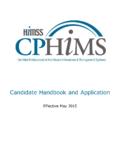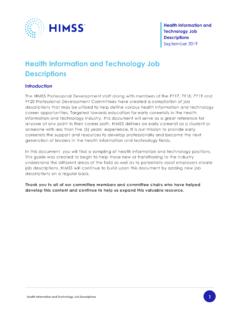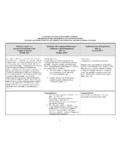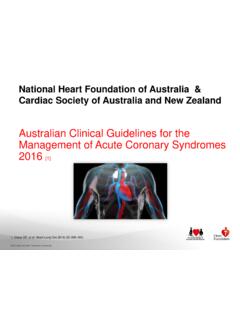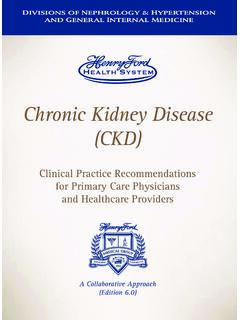Transcription of The Evolution of TIGER Competencies and Informatics Resources
1 The Evolution of TIGER Competencies and Informatics Resources Executive Supplemental ReportPage 2 The Evolution of TIGER Competencies and Informatics ResourcesAuthorsToria Shaw, MSW1, Rachelle Blake, PA, MHA2, Ursula H bner, PhD3, Christel Anderson, MA4, Victoria Wangia-Anderson, PhD, FHIMSS5, Beth Elias, PhD, MS61 Healthcare Information and Management Systems Society, USA; 2 Omni Micro Systems und Omni Med Solutions GmbH, Germany and Omni Micro / Omni Med Solutions, Inc., USA; 3 University of Applied Sciences Osnabr ck, Germany; 4 Healthcare Information and Management Systems Society, USA; 5 University of Cincinnati, OH; 6 Virginia Commonwealth University School of NursingThe TIGER (Technology Informatics Guiding Education Reform) Initiative is focused on education reform, international community development and global workforce development utilizing an interprofessional approach.
2 The guiding spirit of TIGER is to maximize the integration of technology and Informatics into seamless practice, education and research resource advances the integration of health Informatics by enabling you to use Informatics and technology to improve patient care and helping you foster a learning health system. For more information, please find us at A Shared HistoryIn 2006, the TIGER Initiative convened a Summit of nursing stakeholders to develop, publish, and commit to an action plan to make healthcare safer, more effective, efficient, patient-centered, timely and equitable. As an outcome of the Summit, collaborative teams were formed to accelerate the action plan within nine key topic areas. All teams worked on identifying best practices from both education and practice related to their topic, so that this knowledge could be shared with others.
3 The initiative thereby builds upon and recognizes the work of organizations, programs, research, and related initiatives in academia, practice, and government working together towards a common TIGER Informatics Competencies Collaborative (TICC) was formed to develop Informatics recommendations for all practicing nurses and nursing students. Following a review of the literature and a survey of nursing Informatics education, research, and practice groups, the TIGER Nursing Informatics Competencies Model was developed and consists of three parts: 1) Basic Computer Competencies ; 2) Information Literacy; and 3) Information Management (including use of an EHR). In 2011, the group published a landmark report Informatics Competencies for Every Practicing nurse : Recommendations from the TIGER Collaborative.
4 A Collaborative FutureToday, it has been over seven years since the TICC was formed and we have experienced changes, including the need for updated Informatics Competencies . In a changing and dynamic environment, TIGER is continuing to encourage the adoption of Informatics Competencies through existing education, research, and work from practice groups. The Informatics Competencies conversation has shifted from the past with two notable expansions this work has become both interprofessional and global through projects such as TIGER s International Competency Synthesis Project (ICSP), also discussed in this document. With TIGER s ICSP, we aim to marry global and local educational needs. To this end, a global survey was conducted and national case studies were compiled.
5 Based on the findings and results of the survey and case studies, a Recommendation Framework is being populated with international recommendations for cognitive Competencies in nursing and interprofessional coordination of care, aimed at providing a grid to host knowledge about Informatics Competencies , professional roles, priorities and practical experience. It s also important to note that these project findings and case studies were leveraged as the foundation to begin the EU*US eHealth Work Project scope of work and deliverables also shared in-depth later in this report. Page 3 The Evolution of TIGER Competencies and Informatics ResourcesPreviously a standalone Foundation, TIGER transitioned to the Health Information and Management Systems Society (HIMSS) effective September 22, 2014, supported by the Clinical Informatics department.
6 With this transition came a shift to a new interprofessional, interdisciplinary approach. As TIGER has evolved, Informatics pioneers such as Marion J. Ball, Michelle Troseth and countless others recognized the critical need for TIGER to grow into an interprofessional space that can engage with the evolving interprofessional model of now collaborates with and calls upon the work of the European Computer Driving License (EDCL), the Health IT Competencies Tool and Repository (HITComp), TIGER s Virtual Learning Environment (VLE), TIGER s International Competency Synthesis Project and the EU*US eHealth Work Project to continue the conversation around Competencies as well as to add global, interdisciplinary and interprofessional perspectives. In this report, we will discuss each of the collaborative 4 The Evolution of TIGER Competencies and Informatics ResourcesTHE ECDL FOUNDATION.
7 5 HITCOMP TOOL AND REPOSITORY ..7 HITComp Instructions for Use ..8 TIGER S VIRTUAL LEARNING ENVIRONMENT ..12 Open Source Collaboration ..12 Courses Tied to Certificates of Completion ..12 Resource and Curriculum Organization ..13 Tips for Maximizing Time Spent Navigating the Portal & Leveraging Resources ..13 Get Involved with the VLE Community ..13 TIGER S INTERNATIONAL COMPETENCY SYNTHESIS PROJECT..`14 Results ..14 Case Studies: National Informatics Core Competencies ..15 Synergy between Survey Data & Case Studies ..15 Discussion ..16 Conclusion ..16EU*US EHEALTH WORK PROJECT & CONSORTIUM ..17 Key Project Deliverables ..18 How You Can Support This Project.
8 18 CONCLUSION ..19 REPORT APPENDIX ..19 TRANSATLANTIC COLLECTION OF HEALTH Informatics Competencies ..19 HELPFUL TERMS USED ON THE HITCOMP SITE ..20 ABBREVIATIONS & ACRONYMS ..23 REFERENCES ..24 SPECIAL ACKNOWLEDGMENTS ..24 Table of ContentsPage 5 The Evolution of TIGER Competencies and Informatics ResourcesThe ECDL Foundation The European Computer Driving License (ECDL) has the mission to enable proficient use of Information and Communications Technology (ICT) that empowers individuals, organizations and society, through the development, promotion, and delivery of quality certification programs throughout the world. For more information, please visit new ECDL is made up of a range of modules each module provides a practical program of up-to-date skills and knowledge areas, which are validated by a test.
9 The new ECDL enables you to develop and certify your computer skills in the subject areas of your choosing and to the level that you need either for work, or for day-to-day life. Through the module combination that you choose, you can create an individualized ECDL ECDL/ICDL modules are categorized by the three competency levels: basic, intermediate, and advanced. Modules pertinent to health information systems fall under the intermediate category. Other intermediate topics include, using databases, IT Security, Web Editing, Project planning, ICT in Education, among others. BASE MODULESINTERMEDIATE MODULESADVANCED MODULES Computer Essentials Presentation Advanced Word Processing Online Essentials Using Databases Advanced Spreadsheets Word Processing IT Security Advanced Database Spreadsheets Online Collaboration Advanced Presentation Image Editing Web Editing Project Planning 2D Computer Aided DesignHealth Information Systems UsageICT in EducationExample: Health Information Systems UsageThe Health Information System Usage program is an intermediate module of the ECDL program, and has the most pertinent Competencies for interdisciplinary health Informatics .
10 This module is aimed at users of patient information systems, such as physicians, nurses, other healthcare providers, as well as healthcare support staff. It defines the skills necessary to operate a Health Information System (HIS) efficiently and module content recognizes the importance of educating and empowering the end-user at all levels and for all professions. It builds on and complements professional education and practice principles, and generic ICT skills. In addition, it covers the increasingly important area where computer systems used in the health sector may challenge both established professional practice and good data completion of this module the candidate will be able to: Understand the key features of an HIS Use an HIS safely and efficiently Understand the ethics, rules, and regulations relating to an HIS Understand confidentiality, security, and access control when using an HIS Understand and interpret electronically recorded dataECDL/ICDL Health Information Systems UsagePage 6 The Evolution of TIGER Competencies and Informatics ResourcesThe benefits of this particular module include the following.

